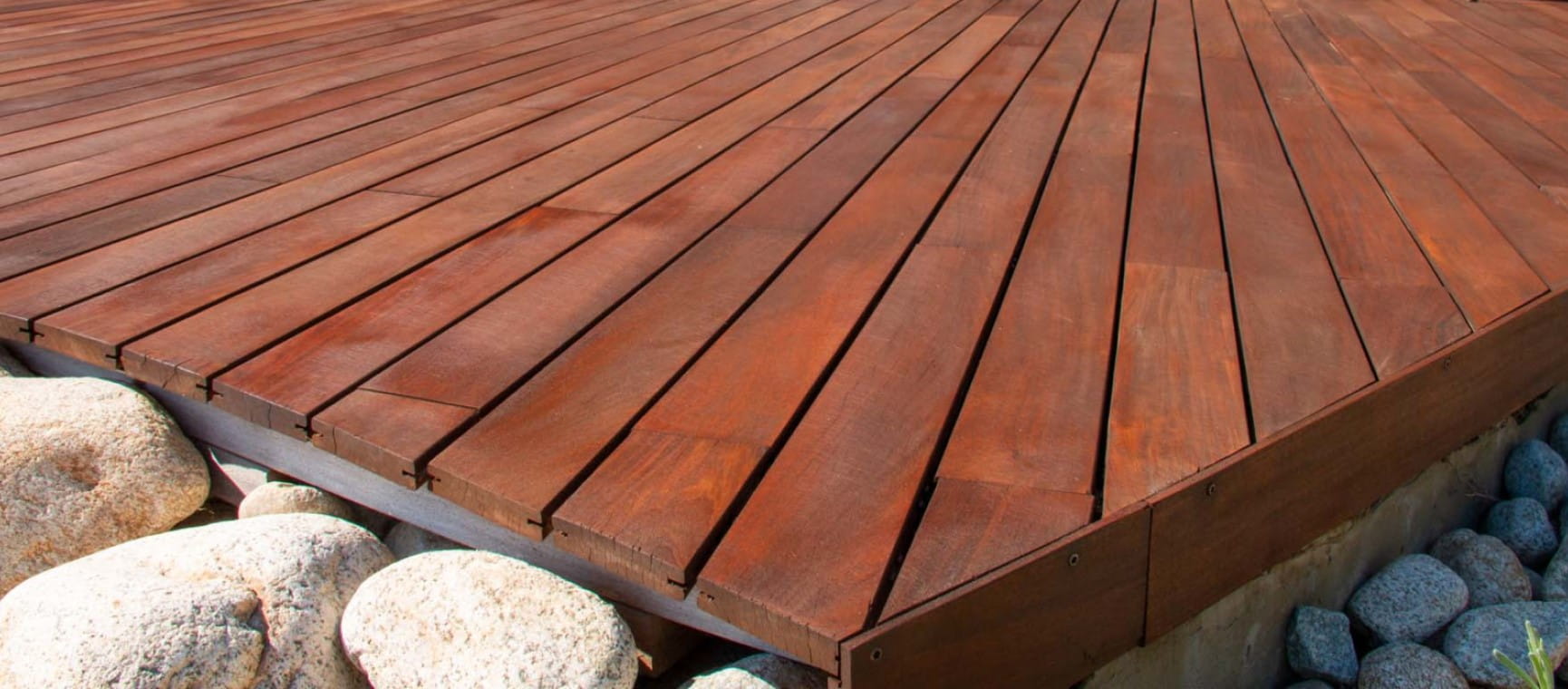How to treat decking for a longer lasting surface
We take you through the process of how to clean and treat your decking with oil and stain to get it ready for the warmer weather

We take you through the process of how to clean and treat your decking with oil and stain to get it ready for the warmer weather

It’s that time of year when we look forward to spending more time in our gardens, but is your decking summer-ready?
Whether you enjoy the social aspect of barbecues with family and friends, eating al fresco in the sunshine or simply sitting peacefully and admiring the view, it’s likely your decking will need some care and attention to get it in ship-shape condition.
On average you can expect timber decking to last between 15 and 30 years, but according to Ronseal, with the right maintenance it can last much longer.
So, with the help of the experts, we’re here to show you how to treat your decking and give it a new lease of life.
“If you’re lucky enough to have decking, you’ll know that it requires annual maintenance,” says a spokesperson at Toolstation.
“It’s common for decking to become green or discoloured with algae or mildew, particularly after winter or a wet period. It can also become slippery and dangerous if not looked after.”
Knowing how to clean and treat your decking isn’t difficult if you follow these steps.
Remove any garden furniture, containers or accessories from the decking to give a clear space for working.
Take hold of a stiff brush and get sweeping to remove the dirt and leaves. You may find a handheld wire brush is needed to tackle tougher dirt.
Be careful to get into all the timber grooves to remove the muck.

“You can then use a simple solution of washing up liquid and soap for a gentle clean, or purchase a specialist decking cleaner,” says the Toolstation spokesperson.
"Whilst both will do the trick, decking cleaner will be more effective in getting rid of stubborn dirt and grime.”
Scrub the deck once more, creating a lather with the cleaning liquid (if you’re using a decking cleaner, check the instructions before use), and rinse with clean water before leaving it to dry.
But don't use too high a setting

Once the deck has been cleaned, you can remove the leftover debris with a pressure washer. It’s a quick and easy way to remove any build-up of moss or grime.
If using a pressure washer, be careful not to use too much pressure, as this can damage the timber. Test the pressure washer on a small area first and hold the hose a good distance from the decking, then start the pressure washer on a gentle setting using a wide spray nozzle. If this isn’t sufficient to clean the deck, increase the pressure gradually.
"I'm a big fan of Kärcher pressure washers – I've owned mine for eight years now and it's still working perfectly," says homes expert Amy Cutmore.
"I've always found it really easy to use thanks to its clever wand system that helps you select the right power for each job, and it's really good at shifting dirt."
Don’t worry if you don’t have a pressure washer, a normal hose will work just as well, although you may need to add a little extra elbow grease with the help of a wire brush.
Ronseal warns against using a pressure washer if you have mould on your decking, as it can cause the spores to spread and make it worse.
The best plan of action is to make sure the mould has been removed before you start.
Black mould can thrive on damp wood. This makes timber decking in shaded areas a perfect breeding ground for mould, as the timber takes longer to dry out than decking positioned in sunny spots. If left untreated, mould will break down the wood fibre, leading to wood rot.
Cleaning the mould off your decking will prevent further long-term damage that would be harder to repair.
Choose between a decking oil or a stain

Now your decking has had a deep clean, it’s time to nourish the timber and protect it from the elements. But which product do you choose: decking oil or decking stain?
Toolstation tells us: “Decking oil is great for repairing and nourishing wooden surfaces as it helps to bring out the natural features in the wood. The oil is designed to penetrate the wood and protect the decking from within, helping to prevent it from warping, splitting, or cracking. If you’d like to keep the natural look of your wooden deck, oil is the preferable choice.”
Oil also has another advantage. “It’s less slippery than stains, as it doesn’t coat the wood with a plastic-like film.
“Its final colour is influenced by the natural colour of the timber – meaning the finish could slightly alter from the image on the packaging.”
However, the spokesperson has a warning: “One thing to remember is that stains will not take to a deck that’s been previously oiled, meaning it’s best to choose between one or the other.”
While oil is the best option for a natural look, a stain will change the colour of your timber to create an entirely different effect. Stain will still work as a preservative, but it will need some maintenance.
“It can crack and peel over time if not maintained or applied correctly,” says Toolstation, “so make sure to prepare your surface before applying the correct amount.”

Ronseal ultimate decking oil in natural 2.5l, £29.99 at Screwfix
Cuprinol UV guard decking oil in natural 2.5l, £29 at Wickes
Ronseal ultimate protection decking stain in slate 2.5l, £34.99 at Screwfix
Cuprinol anti-slip decking stain in Hampshire Oak 2.5l, 2.5l, £29 at Wickes
Before applying either decking oil or stain make sure the timber is completely dry. When applying oil, Liberon recommends giving the oil a good stir before starting to apply it in thin coats using a brush, roller or spray gun.
According to the website: “It’s best to apply the decking oil in sections or plank by plank to provide your wood floor oil protection evenly.”
Apply another thin coat after 20 minutes, then remove the excess oil with a cotton cloth (check the instructions on your product for specific application advice).
The area should be left to dry for at least 24 hours before use.
The technique will depend on the age of the deck
Ronseal advises checking to see if there’s any pre-treatment on your new decking, as this can prevent the stain from sticking, leaving your timber unprotected. If it’s untreated, you can either allow the deck to weather naturally for six months or give the decking a good clean (see above).
Before you start, give the stain a good stir and apply it with a brush along the lengths of the decking, in the direction of the grain. Check the label for the correct drying time before applying another coat.
When applying a stain to an existing deck, there’s more preparation required than when staining a new deck.
Ronseal advises removing any previous treatments of oil or stain with a deck stripper. Although it may seem like an arduous process, it provides a better surface for the new stain to adhere to.
Wait for a warm day before getting to work. Remove any debris from the decking then give the deck stripper a good mix before pouring it onto the deck.
Work the stripper into the timber using a stiff handheld brush and apply more stripper to any areas that dry out. Then wait 30 minutes, or however long it details on the instructions, before scraping the surface with a sharp implement, such as a paint stripper or putty knife.
You may need to wait a few more minutes if the stripper hasn’t worked, however, if it’s ready, get a stiff brush, add some water and get scrubbing.
Then, wash the whole area with a pressure washer. Leave the deck to completely dry before applying the stain – 48 hours is a good guide.
With her 30 years of experience, Camilla Sharman has covered a wide range of sectors within the business and consumer industries both as a feature, content, and freelance writer. As a business journalist, Camilla has researched articles for many different sectors from the jewellery industry to finance and tech, charities, and the arts.
View author page




Blighted by buzzing? How to keep wasps out of your garden without harming them so you can enjoy the summer.

Our expert pruning and watering hacks include a top tip to keep them flowering from Alan Titchmarsh.


Want to know how to get rid of dandelions? Advice on how to tackle them but why they might be worth sparing.
